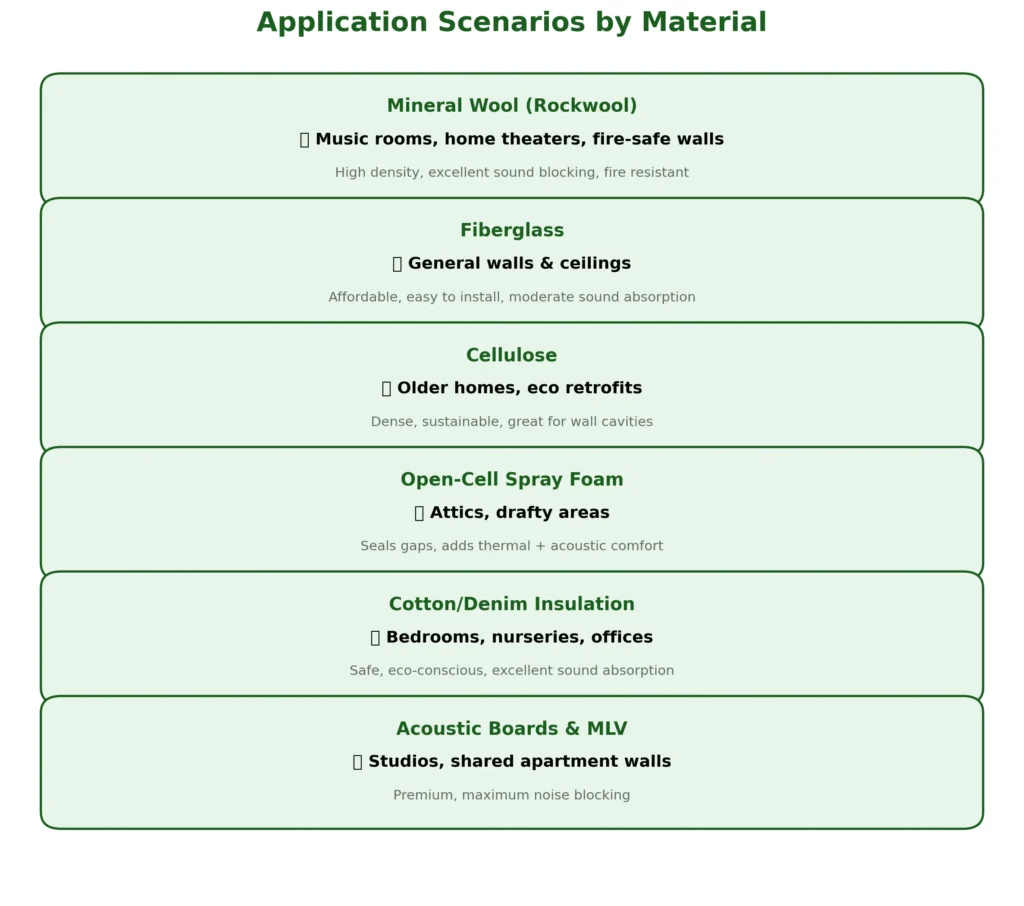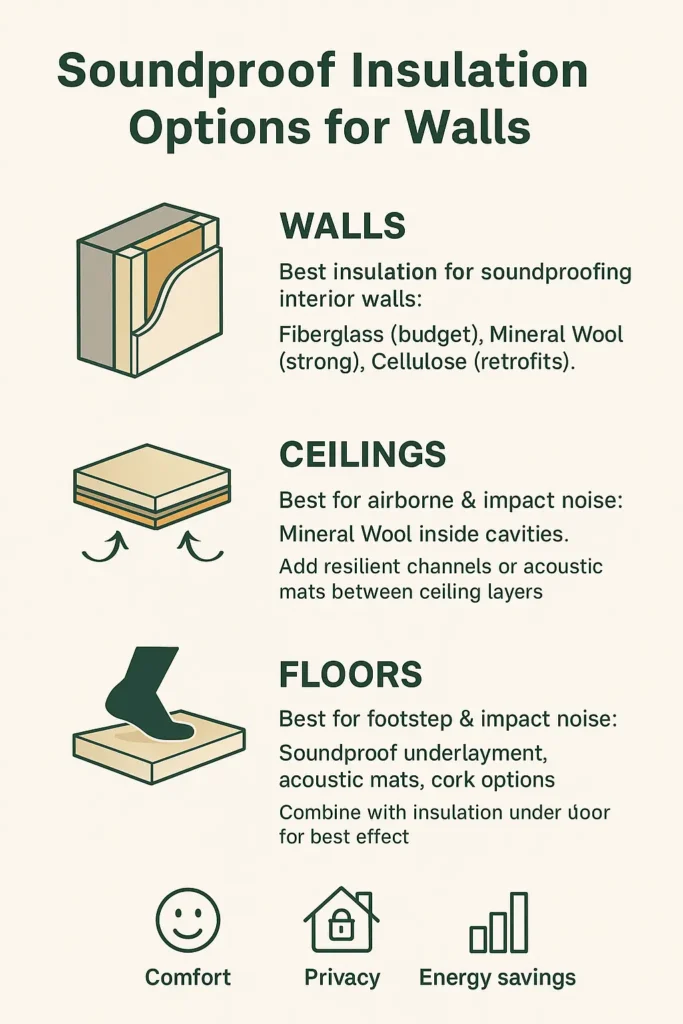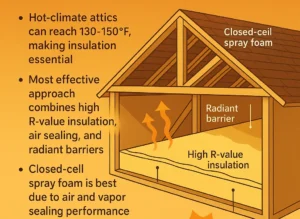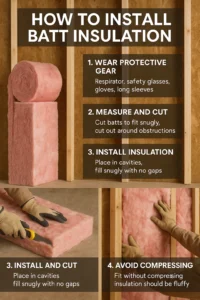Key Takeaways
- What soundproof insulation is and how it works to block and absorb noise.
- The meaning of STC (Sound Transmission Class) and NRC (Noise Reduction Coefficient), and why these ratings matter.
- The best soundproof insulation materials such as mineral wool, fiberglass, cellulose, spray foam, cotton/denim, and acoustic boards.
- Which insulation is best for interior walls, ceilings, and floors, and how a layered system improves results.
- How to compare insulation by cost, STC rating, and best use to match your budget and noise challenge.
- The benefits of soundproof insulation for comfort, privacy, energy savings, and property value.
- Professional installation strategies like decoupling, double drywall, Green Glue, and mass-loaded vinyl (MLV).
- Expert advice on how to combine methods for the best long-term soundproofing results.
The Best Insulation For Soundproofing

People encounter a myriad of noise-related challenges in their daily lives. Whether it’s the cacophony of city life seeping into your home, the disruptive sounds from neighboring apartments, or even the challenge of creating a quieter atmosphere within your own household, the battle against unwanted noise is one that many of us face.
Soundproof insulation is not just about enjoying a peaceful evening or a good night’s sleep; it’s a way to cut out disruptive sounds, reclaim your personal space, and protect your well-being. This kind of insulation acts as an acoustic shield, defending your sanctuary from the intrusive sounds of the outside world.
The need for the best soundproofing insulation product for walls and ceilings is becoming increasingly critical in our bustling, often crowded urban environments.
Are you seeking next-generation insulation products for sound absorption in your homes? Below, you can find a rich menu of choices you need to be aware of. If you require a more comprehensive consultation for the different types of insulation even after reading this information, please don’t hesitate to contact us for a free consultation on insulation materials.
The best insulation materials for soundproofing walls include mineral wool, fiberglass, cellulose, spray foam, and mass-loaded options like vinyl or extra drywall layers, each offering a balance of sound absorption, fire safety, and cost. Choosing the wrong type can lead to poor noise control, sound leaks, moisture issues, safety risks, or wasted money. For balancing cost and performance, mineral wool or dense fiberglass are strong options, especially when paired with sealing, added drywall, or damping compounds. Ultimately, installation quality makes the biggest difference—gaps, poor sealing, or lack of isolation can undermine even the best materials, while careful fitting and sealing maximize effectiveness – Senior Sondprof Expert at Pure Eco Inc
What Is Soundproof Insulation and What’s Its Purpose?
Soundproof insulation, also known as acoustic insulation or sound insulation, is a specialized type of insulation acoustic panels designed to reduce or block sound transmission between spaces. Adding insulation is a crucial component in creating a peaceful and acoustically balanced environment. It’s commonly used in residential and commercial buildings to create quieter, more comfortable, and energy-efficient environments.
Before you consider it, though, ask yourself what you need it for: Are you looking to block external noise, soundproof a room such as your home theater, or minimize noise between rooms? Your specific needs will dictate the type of insulation you should choose depending on the types of sound.
Benefits of Using Soundproof Insulation
Adding soundproof insulation to your home gives you more than just peace and quiet. The main benefit is a quieter living space, where outside noise, loud neighbors, or sounds from other rooms are reduced. This makes daily life more comfortable and less stressful.
It also improves privacy. In home offices, bedrooms, or nurseries, soundproof insulation helps keep conversations and activities more private, so you are not disturbed by others and they are not disturbed by you.
Another advantage is energy efficiency. Most soundproof insulation also works as thermal insulation. This means your home stays warmer in winter and cooler in summer, which can lower your energy bills while also blocking noise.
Finally, installing soundproof insulation can increase property value. A home that is quieter, more private, and more energy efficient is more attractive to buyers and can stand out in the housing market.
The Best Soundproof Insulation Materials
Sound behaves in distinct ways when it encounters surfaces. It can be absorbed, reflected, or transmitted through these surfaces. Soundproofing materials are engineered to manipulate this interaction. They absorb sound energy, preventing it from rebounding and intensifying. Moreover, they serve as an impenetrable barrier, stopping sound waves from infiltrating your living space.
The choice of the best sound insulation materials plays a pivotal role in determining the effectiveness of noise reduction or blocking an amount of noise. A variety of materials is employed, each meticulously chosen for its unique properties and its ability to contribute to the cause of acoustic peace. These materials include:
Mineral wool insulation, also known as rock wool, is an excellent soundproofing option for blocking the transmission of sound. It has a thicker density and effectively absorbs standard sound waves.
Fiberglass insulation used for soundproofing is a versatile choice that provides both thermal and soundproofing benefits. It’s easy to install and readily available.
Cotton Insulation. Made from recycled denim or cotton, this eco-friendly insulation offers a decent option for soundproofing. It’s also safe to handle.
Cellulose insulation is made from recycled paper and treated with fire retardants. It’s an affordable option for soundproofing interior walls and ceilings leaving your house safe and sound.
Spray Foam Insulation (open cell spray / closed cell spray), including spray foam and rigid foam boards, provides excellent sound attenuation when properly installed. It can seal gaps and cracks to prevent sound leakage.
Blown-in insulation, also known as loose-fill insulation, is a type of insulation material consisting of small particles or fibers, such as fiberglass, cellulose, or foam, which is mechanically blown or sprayed into wall cavities, attics, or other spaces to provide thermal and sound insulation.
Batt insulation, often referred to as blanket insulation, is a type of insulation material that comes in pre-cut rectangular sheets or rolls. These are typically made of fiberglass, rockwool, or cotton, and are designed to fit snugly into wall, ceiling, or floor cavities, effectively insulating against heat transfer and sound transmission.
Roxul, a leading name in the insulation industry, offers a range of products known for their exceptional fire resistance and sound-absorbing qualities. Made from rock fibers, this insulation material not only dampens noise but also contributes to thermal insulation, making it an ideal choice for creating acoustically and thermally balanced environments.
Safe n Sound Insulation, also known as S&S Insulation, is another highly regarded material designed specifically for soundproofing applications. Composed of recycled denim and cotton fibers, it boasts both eco-friendliness and excellent sound-absorbing properties. Its ease of installation and versatility have made it a favorite among DIY enthusiasts.
Mass Loaded Vinyl, often abbreviated as MLV, stands as one of the foremost materials in the realm of soundproof insulation. This dense, flexible vinyl sheet carries impressive mass, effectively impeding the progress of sound waves. It is a versatile option, widely used for its ability to absorb and reflect sound energy, making it an essential component in countless soundproofing projects.
Choosing the best insulation for soundproofing depends on your specific needs, budget, and installation requirements. Each of these insulation types excels in certain scenarios, so it’s essential to assess your project’s unique characteristics. Whether you’re aiming to keep external noise at bay or create a serene interior oasis, the right soundproof insulation will achieve results in enhancing your living or working space.
The efficacy of options for soundproofing insulation is contingent not only upon appropriate materials but also on their arrangement and density. To attain optimum results, meticulous planning and application are essential.
Best Sound Insulation for Walls
When looking for the best insulation for soundproofing interior walls, it is important to compare the main options. Fiberglass is affordable and works well for basic noise reduction in bedrooms or living rooms. Mineral wool (Rockwool) is denser and stronger, making it better for home offices, shared walls, or rooms where you need extra quiet. Cellulose can be blown into existing walls, which is useful in older houses.
For the best results, insulation should be part of a layered system. A strong setup usually includes insulation inside the wall cavity, plus two layers of drywall or special soundproof drywall like QuietRock, and sometimes soundproofing mats or mass-loaded vinyl (MLV) between layers. This mix of materials blocks and absorbs sound at the same time, giving you much higher sound protection than insulation alone.
Best Soundproof Insulation for Ceilings and Floors
Noise does not only travel through walls—it also moves through ceilings and floors. There are two main types of noise to think about: airborne sound (like voices or music) and impact sound (like footsteps or dropped objects).
For ceilings, mineral wool works very well because it is dense and absorbs sound waves. Adding resilient channels or acoustic mats between the ceiling layers can stop vibrations from moving from one floor to another.
For floors, the best method is usually to use soundproof underlayment or acoustic mats under the flooring. These materials reduce impact noise such as footsteps. In some cases, cork underlayment can be used as a natural and eco-friendly choice. When combined with insulation below the subfloor, these layers can make upstairs rooms much quieter for people living below.
By covering both ceilings and floors, you block noise in all directions. This is a step many competitors forget, so using these methods can give your home a real advantage in comfort and privacy.
Factors to Consider in Insulation
The choice of material depends on factors such as the specific noise problem, budget, and installation preferences:
Noise Source: Identify the primary sources of noise you want to block. Is it airborne noise (voices, music) or impact noise (footsteps, machinery)?
Sound Transmission Class (STC) Rating: STC measures how effectively a material reduces airborne sound transmission. A higher STC rating indicates better soundproofing.
Installation Area: Consider where you plan to install the insulation, whether it’s walls, ceilings, or floors.
Budget: Your budget will play a significant role in determining the type of insulation you can afford.
STC and NRC Ratings
To make an informed choice, you need to grasp the basics of sound transmission and the various ratings associated with soundproofing materials. Familiarize yourself with terms like Sound Transmission Class (STC) and Noise Reduction Coefficient (NRC). These ratings help determine the effectiveness of soundproof insulation in different scenarios.
STC values typically range from 25 to 60 or higher:
- 25-35 (Lower STC values) indicate poor soundproofing, allowing significant sound transmission.
- 40-50 (Moderate STC values) represent reasonable soundproofing, suitable for typical residential and commercial applications.
- 55-60 and above (Higher STC values ) indicate excellent soundproofing, suitable for critical applications like recording studios or soundproof partitions between noisy and quiet areas.
NRC values range from 0.00 to 1.00:
- 0.20–0.40: Minimal absorption.
- 0.50–0.70: Good absorption for residential spaces.
- 0.80–1.00: Excellent absorption, often used in professional acoustic design.
Comparison of Common Soundproof Insulation Materials
When comparing insulation materials for soundproofing, it’s important to look beyond just the brand names and focus on how each option actually performs. Two key ratings help guide your choice: STC (Sound Transmission Class), which measures how well a material blocks sound from passing through walls, and NRC (Noise Reduction Coefficient), which shows how much sound a material absorbs inside a room. The higher the numbers, the better the soundproofing effect. Cost, installation, and application also matter because the best option for a music studio will not always be the same as the best choice for a bedroom or office.
Each soundproof insulation material works best in certain situations. This article shows where every option performs the strongest, whether it’s mineral wool for home theaters, fiberglass for everyday walls, or acoustic boards for professional studios. Our soundproofing experts at Pure Eco Inc. have created this table to help you quickly compare the options, so you can match the right insulation to your room type and noise challenge and achieve the quiet and comfort you need.
Material | STC Range | NRC Range | Pros | Cons | Cost Level | Best Application |
Mineral Wool (Rockwool) | 50–55 | 0.90–0.95 | Excellent at blocking & absorbing sound; fire-resistant; moisture-resistant | Higher cost than fiberglass; heavier | $$–$$$ | Interior walls, ceilings, and recording studios |
Fiberglass | 39–45 | 0.65–0.75 | Affordable, widely available, easy to install | Less dense than mineral wool; lower STC | $ | Interior walls, ceilings in residential homes |
Cellulose | 44–49 | 0.70–0.80 | Eco-friendly (recycled); dense, good sound damping | Can settle over time; may need professional install | $$ | Older homes, retrofitting walls |
Open-Cell Spray Foam | 35–40 | 0.50–0.70 | Expands to seal gaps; adds thermal + acoustic benefits | Lower STC; not as effective for impact noise | $$$ | Walls, attics, and areas needing air sealing |
Cotton/Denim Insulation | 45–50 | 0.85–0.95 | Safe to handle; eco-friendly; excellent NRC | Limited availability; pricier than fiberglass | $$–$$$ | Bedrooms, offices, eco-conscious projects |
Acoustic Drywall (e.g., QuietRock) | 55–60 | 0.85–0.95 | High STC; strong barrier for airborne sound | Expensive; needs professional installation | $$$ | Home theaters, apartments, shared walls |
*Values represent typical performance when installed correctly with proper wall assemblies.
Choosing the right insulation depends on your priorities. Mineral wool is a strong all-round choice with excellent sound-blocking and fire safety. Fiberglass works best if you are on a tighter budget and want an easy-to-install solution. Cellulose and cotton or denim are attractive options if you want to balance eco-friendliness with good acoustic performance. Open-cell spray foam is ideal for sealing gaps and improving comfort, but it won’t block heavy impact noise as effectively. Acoustic drywall delivers the highest performance but comes at a higher cost and usually requires professional installation.
By comparing the STC and NRC values along with the pros and cons, you can quickly see which insulation is the best match for your home or project.

R-Value – This measures how well insulation keeps heat in or out. Some soundproof materials, like mineral wool and spray foam, also have strong thermal performance. A higher R-Value means better energy efficiency and lower bills.
Allergens – Insulation materials can affect air quality. Fiberglass can sometimes release small fibers, while cotton/denim and cellulose are safer and more natural. Choosing the right product can reduce irritation and make your home healthier.
Sustainability – Many homeowners today want eco-friendly options. Cellulose, cotton/denim, and certain mineral wool products are made from recycled content. This makes them good for the environment while still giving strong sound control.
Application Ease – Some materials are easier to install than others. Fiberglass and mineral wool batts can be placed by homeowners with DIY skills, while spray foam, acoustic boards, or layered systems usually need a professional.
Fire Resistance – Safety is also a key factor. Mineral wool has excellent fire resistance, making it a safe choice for walls and ceilings. Fiberglass is also fire-safe, while cellulose is treated with fire retardants to improve protection.
Looking at these extra points, together with STC and NRC, helps you find insulation that not only reduces noise but also improves comfort, health, safety, and energy savings in your home.
Specialized sound insulation technologies
Soundproofing involves special techniques and applications that can significantly improve the noise reduction in your living space. We’ll look at some of these specialized soundproofing techniques, such as Quiet Rock Installation, Green Glue, and the benefits of using Resilient Channels, Hat Channels, and Resilient Clips.
Quiet Rock Installation: A Quieter Living Space
Quiet Rock is a revolutionary soundproof drywall. Unlike traditional drywall, Quiet Rock integrates multiple layers of specialized materials that act as formidable barriers against sound transmission. These layers effectively dampen vibrations and absorb sound energy, transforming your living space into an oasis of tranquility.
The key to Quiet Rock’s success lies in its density and unique composition, making it a preferred choice for those who demand superior soundproofing. Whether you’re seeking respite from noisy neighbors or the hustle and bustle of city life, Quiet Rock installation can make a substantial difference, ushering in a newfound sense of peace and quiet.
Green Glue: The Secret to Effective Soundproofing
Green Glue is not a standalone material but a specialized damping compound that, when applied between layers of drywall or other construction materials, transforms sound energy into negligible heat. This seemingly simple process results in a dramatic reduction in noise transmission.
One of the remarkable aspects of Green Glue is its versatility. It can be effortlessly integrated into both new construction and renovation projects. Whether you’re soundproofing walls, ceilings, or floors, Green Glue remains a powerful and indispensable tool in your arsenal for achieving superior acoustic performance.
Enhancing Insulation with Resilient Channels
Resilient Channels, Hat Channels, and Resilient Clips are indispensable components in advanced soundproofing projects. They are designed to provide mechanical decoupling of surfaces, effectively breaking the direct path of sound transmission.
Resilient Channels are thin, metal or plastic strips that are attached to wall or ceiling studs. They create a gap between the framing and the surface material, allowing the surface to vibrate independently. This decoupling prevents sound vibrations from traveling through the structure, significantly reducing noise transmission.
Similar to resilient channels, Hat Channels are often used to create airspace between surfaces. This airspace further enhances sound isolation, making it an ideal choice for applications where maximum noise reduction is desired.
Resilient Clips are designed to provide a high level of soundproofing by mechanically isolating the structure from the surface material. They are often used in conjunction with resilient channels for superior soundproofing results.
Installation Strategies & Layered Soundproofing Techniques
Insulation works even better when it is combined with the right installation methods. A layered system can block more noise and make your home much quieter. One popular method is called decoupling. This means adding a small gap between walls or ceilings so that sound vibrations cannot travel easily. Resilient channels or special clips are often used for this.
It is also important to do air sealing. Small cracks and holes let sound pass through. Using acoustic caulk around joints, outlets, and seams can close these gaps. For stronger sound blocking, many people also use two layers of drywall or special panels like QuietRock. Another option is mass-loaded vinyl (MLV). This is a heavy but flexible sheet that can be placed between drywall layers. It adds more mass and makes the wall much better at blocking sound.
By using these techniques together with the right insulation, you create layers that stop, absorb, and reduce noise more effectively than insulation alone.
Expert advice from Beni – Senior Technician Eco Inc.
“Our team always recommends combining insulation with at least one extra soundproofing method, such as double drywall or MLV. This layered approach is the most effective way to achieve long-term results and a truly quiet home.”
Difference between Soundproofing Walls and Soundproofing Ceilings Insulation
Soundproofing walls and soundproofing ceilings both aim to reduce noise transmission. However, they involve different techniques and materials due to the unique challenges presented by each surface. Here’s a breakdown of the key differences between soundproofing walls and soundproofing ceilings:
| Walls | Ceilings | |
| 1. Surface Orientation | Soundproofing walls involves treating vertical surfaces that separate different rooms or areas. This is crucial for blocking sound from neighboring rooms or outdoor sources. | Soundproofing ceilings focuses on horizontal surfaces that separate floors. It primarily targets noise coming from the floor above, such as footsteps or impact noise. |
| 2. Materials and Techniques | Soundproofing walls often involves adding mass and damping to the existing wall structure. Common materials include Mass Loaded Vinyl (MLV), Roxul insulation, and resilient channels. Techniques like double-layer drywall with Green Glue and acoustic sealants are frequently used. | Soundproofing ceilings typically require materials designed for overhead applications, such as specialized acoustic ceiling tiles, resilient clips, hat channels, and MLV. These materials are selected to address the challenges of sound transmission through the ceiling. |
| 3. Installation Complexity | Soundproofing walls can be relatively straightforward, especially if you have access to both sides of the wall (e.g., in a renovation). It often involves adding soundproofing materials to one side of the wall, followed by drywall and finishing. | Soundproofing ceilings can be more challenging due to the weight of materials and the need to secure them overhead. Installing resilient clips and hat channels to create an air gap adds complexity. It may also require removing and replacing the existing ceiling. |
| 4. Impact on Room Aesthetics | Soundproofing walls may have a lesser impact on room aesthetics because it’s easier to integrate soundproofing materials behind or beneath wall coverings, such as paint, wallpaper, or drywall. | Soundproofing ceilings can be more visually noticeable, as it often involves replacing or adding materials to the visible ceiling surface. This can impact the room’s overall appearance and design. |
| 5. Specific Noise Types | Soundproofing walls is particularly effective for blocking airborne noise, such as voices, music, or TV sounds. It’s also beneficial for reducing the transmission of impact noise, like footsteps on the floor above. | Soundproofing ceilings is primarily geared toward minimizing impact noise from above, which includes footsteps, dropped objects, or vibrations transmitted through the floor. |
| 6. Goals and Objectives | Soundproofing walls is often done to enhance privacy between rooms, isolate a home office, or reduce noise from adjacent apartments or noisy neighbors. | Soundproofing ceilings is typically the best way to create a quieter living space by minimizing noise from upstairs, whether it’s from foot traffic, children playing, or other activities. |
The choice between soundproofing walls and soundproofing ceilings depends on your specific noise concerns and objectives. Each has its unique materials, techniques, and challenges, and they can be complementary when addressing overall noise issues in your home.
Installing soundproof insulation correctly is crucial for its effectiveness. Discuss the installation process with a professional or consult reliable guides to ensure you’re getting the most out of your investment. For example, insulating walls, ceilings, and floors might require different techniques. Remember that higher-quality materials often deliver better results and can be a worthwhile long-term investment.
How to Choose the Best Soundproofing Insulation for Your Home

First, think about your budget. Fiberglass is the cheapest and still gives good results for everyday noise. Mineral wool, acoustic boards, or MLV cost more but deliver much higher sound protection.
Next, look at the type of noise you want to stop. If it is airborne noise like voices, music, or TV, materials with high density such as mineral wool or cellulose work well. If it is impact noise like footsteps or dropped objects, you need mats, underlayment, or resilient channels for better results.
Consider how the room is used. Bedrooms and home offices need quiet and privacy, while home theaters and studios demand strong soundproofing. For older houses, cellulose or blown-in insulation may be the easiest way to improve walls without major construction.
Finally, check the installation difficulty. Some products, like fiberglass batts, are DIY-friendly. Others, like spray foam, acoustic drywall, or full-layered systems, usually need a professional to install them correctly.
At Pure Eco Inc., our experts often recommend a layered approach: combine insulation inside the wall or ceiling with double drywall, Green Glue, or mass-loaded vinyl. This creates a complete system that blocks, absorbs, and reduces sound more effectively than any single material.
The best soundproof insulation for your home is the one that fits your budget, targets your noise problem, and works for your space. With the right choice and proper installation, you can enjoy a quieter, more private, and more comfortable home.
Trust Pure Eco Inc. for Your Soundproof Insulation
The amount of sound that infiltrates your interior from exterior walls can significantly impact your comfort and peace. By choosing the best soundproofing material tailored to your needs, you can create a serene and tranquil environment within your home.
To find out how you can enjoy a home free from the disturbances of the outside world, contact Pure Eco Inc. — the soundproof insulation experts.
The best insulation materials for soundproofing walls include mineral wool, fiberglass, cellulose, spray foam, and mass-loaded options like vinyl or extra drywall layers, each offering a balance of sound absorption, fire safety, and cost. Choosing the wrong type can lead to poor noise control, sound leaks, moisture issues, safety risks, or wasted money. For balancing cost and performance, mineral wool or dense fiberglass are strong options, especially when paired with sealing, added drywall, or damping compounds. Ultimately, installation quality makes the biggest difference—gaps, poor sealing, or lack of isolation can undermine even the best materials, while careful fitting and sealing maximize effectivenes
Eli, Senior Technician at Pure Eco Inc.
FAQs
What are the best materials for soundproof insulation?
Several materials are effective for soundproof insulation, including fiberglass, mineral wool, cellulose, foam panels, and mass-loaded vinyl. The best material for your project depends on factors like your budget, the level of soundproofing needed, and the installation area. Always choose the right material to achieve the desired level of soundproofing. Roxul, fiberglass, and spray foam are highly regarded options because of their superior soundproofing capabilities.
Where should I install soundproof insulation in my home or office?
You should place soundproof insulation strategically in areas where noise transfer is a concern. Common locations include walls between rooms, ceilings, or floors and between different levels of a building as well as around noisy equipment or appliances. The specific placement will depend on your noise problem and your goals for sound reduction.
How effective is soundproof insulation at reducing noise?
The effectiveness of soundproof insulation varies depending on the material used, its thickness, and the quality of installation. In general, soundproof insulation provides a means for reducing significantly noise levels, making spaces quieter and more comfortable. However, note that no insulation can completely eliminate all sound; it can only reduce it to a more tolerable level.
What is the ideal R-rating for soundproofing purposes?
When it comes to soundproofing services, the R-rating, which measures a material’s thermal resistance, may not be the primary consideration. Soundproofing relies more on the material’s ability to absorb, block, or dampen sound waves, which is typically measured by its Sound Transmission Class (STC) or Noise Reduction Coefficient (NRC) rating. The appropriate STC or NRC rating for soundproofing depends on the level of noise you want to reduce and the specific application. Generally, the higher the STC ratings or NRC ratings the better the soundproofing performance.
What is the most cost-effective soundproofing insulation option?
The least expensive insulation option for soundproofing is typically fiberglass insulation. It is widely available and at a relatively affordable cost compared to other materials like Rockwool or spray foam. However, the effectiveness of soundproofing may vary based on the specific application.
Sources
https://www.acousticalsurfaces.com/blog/acoustics-education/nrc-rating-101/
https://www.acousticalsurfaces.com/blog/acoustics-education/sound-transmission-class-stc-rating/
https://thermtest.com/the-top-eco-friendly-insulation-materials
https://www.rockwool.com/north-america/products/
https://www.energy.gov/energysaver/weatherize/insulation/types-insulation
https://en.wikipedia.org/wiki/Sound_transmission_class
https://en.wikipedia.org/wiki/Noise_reduction_coefficient
https://www.greengluecompany.com/noiseproofing-products/sealant







